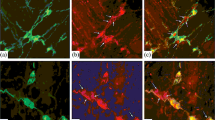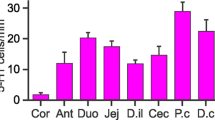Abstract
Serotonin-immunoreactive, i.e. enterochromaffin (EC) cells were found to be widely distributed in the intestine of the newly hatched chick but sparse in the stomach, and being particularly abundant in the duodenum, upper ileum and rectum. Although in birds, as in mammals, EC cells are most abundant in the intestine, in the stomach they are far sparser than in mammals. Comparison of adjacent sections immunostained for serotonin and a peptide provided no evidence that EC cells in the hatching chick contain motilin or substance P, and that at least the great majority of bombesin-immunoreactive cells contain no serotonin: it is apparent that the mammalian pattern of distribution of peptides in EC cells does not occur in the chick, at least at hatching. Cross reaction of an antiserum to substance P with serotonin was discovered, suggesting the need for a review of existing evidence for co-localisation of this peptide with serotonin.
Similar content being viewed by others
References
Alumets J, Håkanson R, Sundler F, Chang K-J (1978) Leu-enkephalin-like material in nerves and enterochromaffin cells in the gut. An immunohistochemical study. Histochemistry 56:187–196
Andrew A (1976a) Intestinal endocrine cells of chicks around the time of hatching. Cell Tissue Res 172:541–551
Andrew A (1976b) Endocrine cells of the stomach of chicks around the time of hatching. Cell Tissue Res 172:553–561
Brodin E, Alumets J, Håkanson R, Leander S, Sundler F (1981) Immunoreactive substance P in the chicken gut: distribution, development and possible functional significance. Cell Tissue Res 216:455–469
Buffa R, Solovieva I, Fiocca R, Giorgino, S, Rindi G, Solcia E, Mochizuki T, Yanaihara C, Yanaihara N (1982) Localization of bombesin and GRP (gastrin releasing peptide) sequences in gut nerves or endocrine cells. Histochemistry 76:457–467
Christofides ND, Bryant MG, Ghatei MA, Kishimoto S, Buchan AMJ, Polak JM, Bloom SR (1981) Molecular forms of motilin in the mammalian and human gut and human plasma. Gastroenterology 80:292–300
Conlon JM, Katsoulis S, Schmidt WE, Thim L (1988) [Arg3] substance P and neurokinin A from chicken small intestine. Regul Pept 20:171–180
Creugh T, Shrabanek P, Cannon D, Balfe A, Powell D (1980) Phylogeny of substance P. Gen Comp Endocrinol 40:503–506
Cutz E, Chan W, Track NS (1981) Bombesin, calcitonin and leuenkephalin immunoreactivity in endocrine cells of human lung. Experientia 31:765–767
D'Este L, Biancone S, Renda T (1986) Ontogenesis of 5-hydroxytryptamine-like immunoreactive cells and their relationship with bombesin in chicken proventriculus. Basic Appl Histochem 30:109–117
Dey RD, Hoffpauir J (1984) Ultrastructural immunocytochemical localization of 5-hydroxytryptamine in gastric enterochromaffin cells. J Histochem Cytochem 32:661–666
Dockray GJ, Vaillant C, Walsh JH (1979) The neuronal origin of bombesin-like immunoreactivity in the rat gastrointestinal tract. Neuroscience 4:1561–1568
Ferreira MN (1966) On the existence of two ultrastructural types of enterochromaffin cells in the duodenum of the chick embryo. Arch Port Sci Biol 15:75–86
Gabe M (1973) Contribution à l'histologie des cellules endocrines duodénales des sauropsidés. Acta Anat (Basel) 85:434–449
Grota LJ, Brown GM (1974) Antibodies to indolealkylamines: serotonin and melatonin. Can J Biochem 52:196–202
Heitz P, Polak JM, Timson TM, Pearse AGE (1976) Enterochromaffin cells as the endocrine source of gastrointestinal substance P. Histochemistry 49:343–347
Ikeda H, Inugai H, Gotoh J (1971) Localization of monoamine-containing fibers and cells in the alimentary canal of chickens. Jpn J Vet Sci 33:187–193
Kishimoto S, Polak JM, Buchan AMJ, Verhofstad AAJ, Steinbusch HWM, Yanaihara N, Bloom SR, Pearse AGE (1981) Motilin cells investigated by the use of region-specific antisera. Virchows Arch [B] Cell Pathol 36:207–218
Kobayashi S, Iwanaga T, Fujita T, Yanaihara N (1980) Do enterochromaffin (EC) cells contain motilin? Arch Histol Jpn 43:85–98
Kramer B, Andrew A, Rawdon BB, Becker P (1987) The effect of pancreatic mesenchyme on the differentiation of endocrine cells from gastric endoderm. Development 100:661–671
Kronheim S, Sheppard MC, Pimstone BL (1980) Substance P release from rat hypothalamus and spinal cord. S Afr Med J 57:827–830
Lane BP, Europa DL (1965) Differential staining of ultrathin sections of Epon-embedded tissue for light microscopy. J Histochem Cytochem 13:579–582
McDonald TJ, Jornvall H, Ghatei G, Bloom SR, Mutt V (1980) Characterization of an avian gastric (proventricular) peptide having sequence homology with the porcine gastrin-releasing peptide and the amphibian peptides bombesin and alytesin. FEBS Lett 122:45–48
Monesi V (1960) The appearance of enterochromaffin cells in the intestine of the chick embryo. Acta Anat (Basel) 47:97–114
Nemoto N, Kawaoi A, Okano T, Ushiyama H, Saton H, Shikata, T (1984) Immunohistochemistry of serotonin (5-HT) in the human gut endocrine cells — an application of ultrastructural immunohistochemistry. Acta Histochem Cytochem 16:577–588
Nihei K, Iwanaga T, Yanaihara N, Mochizuki T, Fujita T (1983) Preproenkephalin A occurs in the enterochromaffin (EC) cells of the porcine intestine: an immunocytochemical study using antisera to met-enkephalin-arg6-gly7-leu8 and to serotonin. Biomed Res 4:393–398
Pearse AGE, Polak JM (1975) Bifunctional reagents as vapour and liquid phase fixatives for immunohistochemistry. Histochem J 1:179–186
Pearse AGE, Polak JM, Bloom SR, Adams C, Dryburgh JR, Brown JC (1974a) Enterochromaffin cells of the mammalian small intestine as the source of motilin. Virchows Arch [B] Cell Pathol 16:111–120
Pearse AGE, Polak JM, Adams C, Kendall, PA (1974b) Diethylpyrocarbonate, a vapour-phase fixative for immunofluorescence studies on polypeptide hormones. Histochem J 6:347–352
Pettilä A (1968a) Embryological aspects of the relationship of 5-hydroxytryptamine to enterochromaffin cells. Ann Med Exp Fenn 46:457–465
Penttilä A (1968b) Enterochromaffin cells in the chicken duodenum during prenatal development. Z Zellforsch 91:380–390
Polak JM, Buchan AMJ (1979) Motilin: immunocytochemical localization indicates possible molecular heterogeneity or the existence of a motilin family. Gastroenterology 76:1065–1066
Polak JM, Pearse AGE, Adams C, Garaud J-C (1974) Immunohistochemical and ultrastructural studies on the endocrine polypeptide (APUD) cells of the avian gastrointestinal tract. Experientia 30:564–567
Portela-Gomes GM, Grimelius L, Peterson R, Bergstrom R (1984) Enterochromaffin cells in the rat gastrointestinal tract. Aspects of factors influencing quantification. Ups J Med Sci 89:189–205
Rawdon BB (1978) Preventing evaporation of antiserum during indirect immunocytochemical staining. Stain Technol 53:289–290
Rawdon BB, Andrew A (1979) An immunocytochemical study of the distribution of pancreatic endocrine cells in chicks with special reference to the relationship between pancreatic polypeptide- and somatostatin-immunoreactive cells. Histochemistry 59:189–197
Rawdon BB, Andrew A (1981) An immunocytochemical survey of endocrine cells in the gastrointestinal tract of chicks at hatching. Cell Tissue Res 220:279–292
Roth KA, Gordon JI (1990) Spatial differentiation of the intestinal epithelium: analysis of enteroendocrine cells containing immunoreactive serotonin, secretin and substance P in normal and transgenic mice. Proc Natl Acad Sci USA 87:6408–6412
Rutschke E (1976) Occurrence and frequency of enterochromaffin cells in the intestine of birds. Z Mikrosk-Anat Forsch 90:284–289
Schipper J, Tilders FJH (1983) A new technique for studying specificity of immunocytochemical procedures: specificity of serotonin immunostaining. J Histochem Cytochem 31:12–19
Sundler F, Alumets J, Håkanson R (1977) 5-Hydroxytryptamine-containing enterochromaffin cells: storage site of substance P. Acta Physiol Scand Suppl 452:121–123
Takahashi S, Yui R (1983) Gastrin-releasing peptide (GRP) and serotonin in the human fetal lung — an immunohistochemical study. Biomed Res 4:315–320
Timson CM, Polak JM, Wharton J, Ghatei MA, Bloom SR, Usellini L, Capella C, Solcia E, Brown MR, Pearse AGE (1979) Bombesin-like immunoreactivity in the avian gut and its localisation to a distinct cell type. Histochemistry 61:213–222
Toner PG (1964) The fine structure of argyrophil and argentaffin cells in gastrointestinal tract of fowls. Z Zellforsch 63:830–839
Usellini L, Tenti P, Fiocca R, Capella C, Buffa R, Terenghi C, Polak JM, Solcia E (1983) The endocrine cells of the chicken proventriculus. Basic Appl Histochem 27:87–102
Vaillant C, Dockray GJ, Walsh JH (1979) The avian proventriculus is an abundant source of endocrine cells with bombesin-like immunoreactivity. Histochemistry 64:307–314
Voller A, Bartlett A, Bidwell DE (1978) Enzyme immunoassays with special reference to ELISA techniques. J Clin Pathol 31:507–520
Watanabe T, Chikazawa H, Chungsamarnyart N, Fujioka T, Yamada Y (1987) Serotonin-storing cells of the chicken duodenum: light, fluorescence, electron microscopy and immunohistochemistry. Cell Tissue Res 247:25–32
Yamada J, Yoshino M, Yamashita T, Misu M, Yanaihara N (1979) Distribution and frequency of gastrin cells in the digestive tract of the Japanese quail. Arch Histol Jpn 42:33–39
Yamada J, Kitamura N, Yamashita T (1985) The relative frequency and topographical distribution of somatostatin-, GRP-, APP-, glucagon-, 5-HT-, and neurotensin-immunoreactive cells in the proventriculus of seven species of birds. Arch Histol Jpn 48:305–314
Yamada J, Kitamura N, Yamashita T, Yanaihara N (1986) Immunohistochemical studies on the endocrine cells in avian gizzard. Biomed Res 7:39–45
Yanaihara N, Yanaihara C, Nagai K, Sato H, Shimizu F, Yamaguchi K, Abe K (1980) Motilin-like immunoreactivity in porcine, canine, human and rat tissues. Biomed Res 1:76–83
Author information
Authors and Affiliations
Rights and permissions
About this article
Cite this article
Rawdon, B.B., Andrew, A. Distribution of serotonin-immunoreactive gut endocrine cells in chicks at hatching. Histochemistry 102, 93–100 (1994). https://doi.org/10.1007/BF00269012
Accepted:
Issue Date:
DOI: https://doi.org/10.1007/BF00269012




